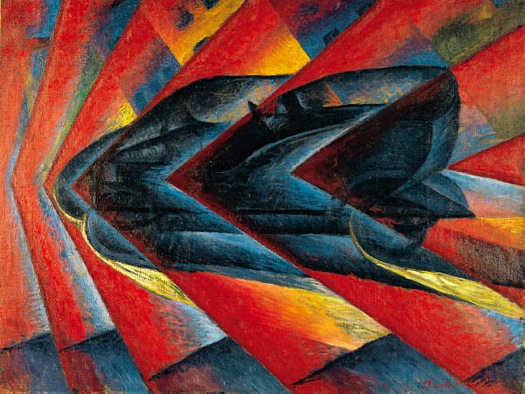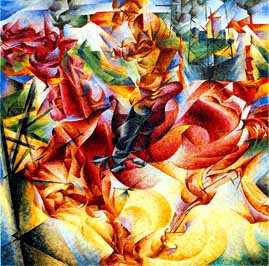
Thanks to the generosity of friends in Solihull I have membership of the Tate and was glad to escape from the pressures of work to see the exhibition of some of the Futurists work in the glorious building.

Tate Modern celebrates the centenary of this dramatic art movement with a ground-breaking exhibition. The colour and energy were captivating. I was less certain about the politics of it all.
Drawing upon elements of Divisionism and Cubism, the Futurists created a new style that broke with old traditions and expressed the dynamism, energy and movement of their modern life.
Futurism was an art movement that originated in Italy in the early 20th century. It was largely an Italian phenomenon, though there were parallel movements in Russia, England and elsewhere.
The Italian writer Filippo Tommaso Marinetti was its founder and most influential personality. He launched the movement in his Futurist Manifesto, which he published for the first time on 5 February 1909 in La gazzetta dell’Emilia, an article then reproduced in the French daily newspaper Le Figaro on 20 February 1909. In it Marinetti expressed a passionate loathing of everything old, especially political and artistic tradition. “We want no part of it, the past”, he wrote, “we the young and strong Futurists!”
The Futurists admired speed, technology, youth and violence, the car, the airplane and the industrial city, all that represented the technological triumph of humanity over nature, and they were passionate nationalists.
The Futurists practiced in every medium of art, including painting, sculpture, ceramics, graphic design, industrial design, interior design, theatre, film, fashion, textiles, literature, music, architecture and even gastronomy.
This exhibition both showcases the work of key Futurists such as Giacomo Balla, Umberto Boccioni and Gino Severini and explores art movements reacting to Futurism. Highlights include Boccioni’s dynamic bronze Unique Forms of Continuity in Space 1913 and Picasso’s Head of a Woman (Fernande) 1909 as well as major works by artists such as Braque, Malevich and Duchamp.
Here are some examples:


Boccioni

Perhaps the Church needs a futurist movement??

The first painting is Luigi Russolo “Automobil”.